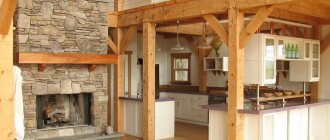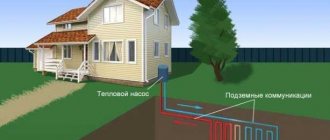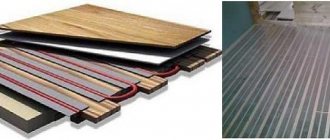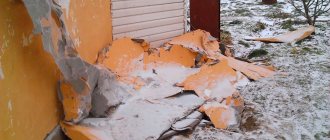Home Installation
Date of publication: 03.08.2015
0
9487
- Construction Basics
- Construction technology
- What you need to install
- Construction stages
- External finishing
- How to avoid the cold bridge
If we turn to the dictionary, we find out that the pediment is the end (most often triangular, sometimes semicircular) of the facade of the building. The pediment is limited by two roof slopes on the sides, and a cornice is located at its base. There are more than 10 types of pediments that can be found on various buildings, both historical and modern. But today we will take a look at the frame pediment.

The frame pediment looks very advantageous if it is trimmed with glass.
Probably, even at the level of project development, you had a question about how to make every element of your home safe, durable and strong. As for the frame pediment, this is doubly correct - a poorly designed part of the house can lead to uneven shrinkage of the building, provoke weight distortion and cracks in the walls. The pediment should be arranged in such a way as to evenly distribute the loads on the frame of the entire building.
Modern technologies today have greatly simplified the construction of the pediment. The rafter system with accompanying elements is a single structure that descends freely and evenly during the shrinkage of the building.
It is frame construction that allows you to create roofs of various shapes, sizes and devices.
You can build an attic or attic, or use the free space under the roof in a different way. The construction of the entire structure is simple and convenient, but it requires some experience and knowledge.
The frame type of construction, due to its lightness, can be considered the simplest in execution, durable and reliable. The main thing is that its elements are correctly and efficiently treated with wood protection.
What is a pediment?
Before proceeding with the warming of the pediment, it is advisable to understand what it is and understand its role in the structure of the house.


And so, briefly about the gables:
- basically the pediment plays the role of a support for the cross beams, which significantly increases the pressure that the roof exerts;
- as a rule, gables receive a large amount of wind action, in this regard, on the leeward side, they perform a blind pediment without doors and windows;
- the pediment should be erected only after the roof has been created, otherwise this structure may collapse due to the skewing of the rafter system;
- the pediment is the least protected relative to other parts of the house, therefore it is imperative to insulate the attic pediment from the inside or outside;
- the pediment is insulated according to the same rules and standards, using the same insulation as other parts of the house.
Pediment - what is it?
Let's take a look at each point that relates to this design:
- The gable is the supporting element for the cross beams. This increases the pressure generated by the roof.
- The pediment absorbs almost all wind impact. Therefore, in a place that is leeward, the pediment is made without windows and doors. They make him deaf.
- The gable only needs to be built when you have completed the roof. Otherwise, due to the skewing of the rafters, the entire structure may collapse, literally collapse.
- The pediment has practically no protection, so it must be insulated from two sides: inner and outer.
- Like other parts of the entire building, this element of the attic is insulated in the same way.
Let's go directly to the insulation of this structure.
The difference between external and internal insulation of the gable
To determine the difference between these types of insulation, let us turn to the term "dew point", since the effectiveness of the insulation work depends on it. The dew point (TP) is called the air temperature at which the moisture in it reaches its maximum saturation and, as a result, falls out in the form of condensation on the surface of the wall (or other plane).
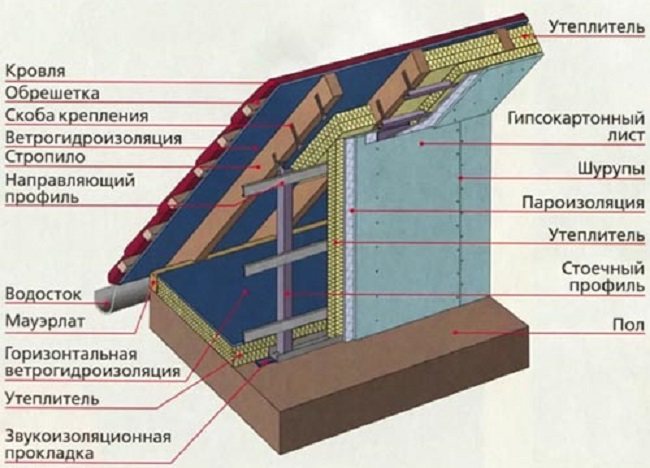

Important! To determine the dew point, it is necessary to take into account the relative air humidity (RHC), besides, the higher this indicator, the more t˚C TP tends to the actual t˚C air. In this regard, it is necessary to create such insulation so that the Ross point is maximally displaced towards the street or is in the thickness of the insulation.
Insulation of the attic pediment from the inside is as effective as from the outside, but the insulation procedure must be performed taking into account the smallest nuances. Poorly insulated areas, more than others are susceptible to condensation on their surface. Particular attention should be paid to corner and butt joints, since these are the places most susceptible to moisture settling. To determine the "dew point", you can use a special technique using special physical and mathematical functions, but not everyone has a technical mindset, therefore, to simplify this procedure, the following table was created:
| t˚C air | ОВВ, Rh | |||||||
| 0.3 | 0.4 | 0.5 | 0.6 | 0.7 | 0.8 | 0.9 | 0.95 | |
| -10 | -23.2 ° C | -20.4 ° C | -17.8 ° C | -15.8 ° C | -14.1 ° C | -12.6 ° C | -10.6 ° C | -10 ° C |
| -5 | -18.9 ° C | -15.8 ° C | -13.3 ° C | -10.9 ° C | -9.3 ° C | -8.1 ° C | -6.5 ° C | -5.8 ° C |
| -14.5 ° C | -11.3 ° C | -8.7 ° C | -6.2 ° C | -4.4 ° C | -2.8 ° C | -1.3 ° C | -0.7 ° C | |
| 5 | -10.5 ° C | -7.3 ° C | -4.3 ° C | -2.2 ° C | -0.1 ° C | + 1.6 ° C | + 3.3 ° C | + 4.1 ° C |
| 10 | -6.7 ° C | -3.2 ° C | -0.3 ° C | + 2.2 ° C | + 4.4 ° C | + 6.4 ° C | + 8.2 ° C | + 9.1 ° C |
| 15 | -2.9 ° C | + 0.8 ° C | + 4.0 ° C | + 6.7 ° C | + 9.2 ° C | + 11.2 ° C | + 13.1 ° C | + 14.1 ° C |
| 20 | + 1.0 ° C | + 5.2 ° C | + 8.7 ° C | + 11.5 ° C | + 14.0 ° C | + 16.2 ° C | + 18.1 ° C | + 19.1 ° C |
| 30 | + 9.5 ° C | + 13.9 ° C | + 17.7 ° C | + 21.3 ° C | + 23.8 ° C | + 26.1 ° C | + 28.1 ° C | + 29.0 ° C |
| 40 | + 17.9 ° C | + 22.6 ° C | + 26.9 ° C | + 30.3 ° C | + 33.0 ° C | + 35.6 ° C | + 38.0 ° C | + 39.0 ° C |
In this regard, insulating the attic pediment from the outside is a more acceptable method, since the "dew point" is already by definition outside, where, when exposed to winds and sunlight, excess moisture will evaporate and not accumulate on the surface of the wall.
Methods for insulating the attic pediment


Due to severe frosts in winter in different areas, the owner of the house thinks about high-quality insulation of its parts. The attic is no exception, because many home owners use this room as a living room, so proper thermal insulation should be carried out. Consider the external and internal insulation of the attic gables.
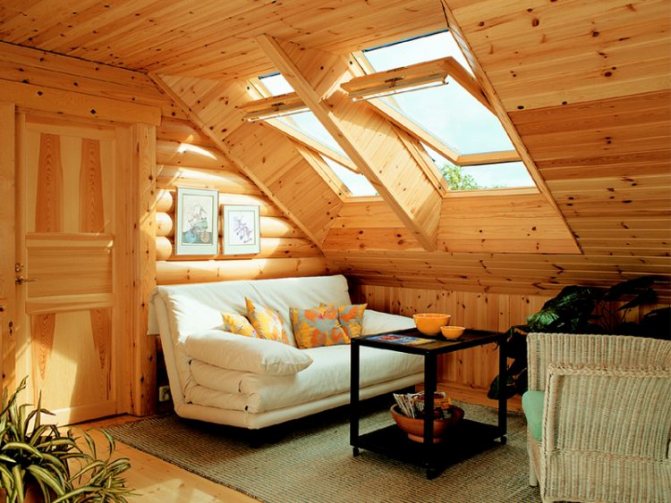

To date, country cottages, in which you can live daily, are very popular. Therefore, often in such cottages, the attic is a living space. The main thing is to achieve a comfortable and cozy temperature. This article will answer the question: how to insulate the pediment?
Materials for insulating the attic outside
Various materials can be used for thermal insulation of the attic outside, but whatever material the choice falls on, it must have the following performance characteristics:
- resistance to mold and moss germination;
- durability;
- maximum thermal insulation;
- environmental friendliness;
- fire safety;
- maintaining performance over time.
As relevant for this type of work, the following types of insulation can be distinguished, since they have all the above properties:
- Glass wool. The material known to all has a long history. High resistance to fire, low thermal conductivity and a democratic price make this material a fairly acceptable material, but the inconvenience of work significantly increases the time of insulation measures, and in some people it causes allergic reactions associated with the content of glass fibers in the composition.
- Minvata. It is a safer and more environmentally friendly glass wool option. In addition, it does not tend to absorb moisture and has excellent sound insulation.Therefore, attic insulated with mineral wool are suitable for creating living rooms or libraries (if the house has a high roof).


Insulating material such as expanded polystyrene requires special attention. This material comes in two versions, consider them:
- Styrofoam. The classical modification of expanded polystyrene, which consists of 98% of weightless granules with an impermeable shell. They undergo short-term high-temperature sintering, which gives the foam all the necessary qualities. As a result, the granules are pressed together and form a slab of the required size.
- Penoplex (extruded foam). The foamed mass of polystyrene is passed through the head of a special extruder, which leads to the formation of foam. In all respects, this material is superior to polystyrene, therefore, the insulation of the attic pediment from the outside with penoplex is, one might say, the most acceptable option.
How to insulate attic gables - types of insulation
Insulation of the attic pediment from the outside is carried out with materials intended for the walls of the house. One of such heaters is polyethylene foam. One side of it is covered with a thin layer of foil; when installing this building material, this surface is attached to the house, which allows heat to be reflected back. Before laying the foamed polyethylene, the entire surface should be treated with a special antiseptic.
Also found its application for similar purposes and foam. Since this material is only responsible for retaining the heat of the room, an additional layer of hydro and vapor barrier is needed, which will protect the insulation itself and prevent moisture from penetrating inside. First, the slabs are attached to the pediment with glue, and then they are additionally fixed with special dowels. For maximum effect, all crevices and gaps should be treated with polyurethane foam.
Attic insulation with foam
Insulating the attic gable with foam is a very laborious work with the use of scaffolding, therefore, before starting such a procedure, you need to take care of the appropriate safety measures, since the insulation will be performed at a height where you need to be extremely careful. And so, the process of external insulation of the attic consists of the following stages:
- Preparing the walls. The surface of the wall must be cleaned of dust and dirt, and then opened with a special primer, which will ensure reliable adhesion of the foam to the wall. The primer is applied in several layers. The application of each new layer is possible only after the previous one has completely dried.
- Installation of the lathing. The lathing is needed so that at the end of the attic insulation, the wall can be covered with decorative facing material (siding). For the lathing, two types of materials are used: wood or metal profile. There is more fuss with the tree, it must be covered with a special anti-corrosion solution so that it does not rot and mold under the influence of moisture. The lathing consists of a layer of horizontal beams, the size of which should be equal to the thickness of the foam (at least 50 mm). The step between the beams should also be repelled by the width of the insulation plate.
Gable insulation technology
In the meantime, I will tell you how the attic gables are insulated. As you understood, there are only two ways of insulation: internal and external. I'll start with the latter as it is more efficient.
Method 1 - External thermal insulation
Despite all the advantages of extruded polystyrene foam, more often in my work I had to use regular foam. Therefore, I will tell you about this technology.
The gables are located in the upper part of the house, therefore scaffolding or devices that replace them are needed to carry out the insulation. I do not recommend using a ladder, as you will quickly get tired of running it up and down.
So, I'm telling you how I insulated the attic gables with foam:
- The first step was to prepare the walls. He cleaned them of dirt and dust, and then primed. The primer will provide better adhesion of the glue to the surface, that is, the thermal insulation itself (foam) will hold more reliably.


The pediment must be free of dust and debris before starting work.
I recommend priming in two layers, and start working on the next one only after the previous one is completely dry.
- After that, I mount the crate. I decided to make it so that later there was where to attach the facing material, that is, vinyl siding.


Gable lathing made of galvanized profile.
For lathing, you can use wood or a galvanized metal profile. I would not recommend a tree for outdoor installation, as it does not tolerate the destructive effects of atmospheric moisture and significant temperature fluctuations.
Galvanizing does not need to be additionally treated with antiseptics and impregnated with hydrophobic compounds.
The height of the lathing beams should be such that it matches the thickness of the foam you purchased. Sheets of 5 cm thickness are usually used, but they can be laid in two layers for thermal insulation measures to be as effective as possible.
I also want to say about the step between adjacent cladding parts. It should be equal to the width of the foam sheet. Then you do not have to trim and the heat-insulating material will be consumed more economically.
- I lay down the foam. To do this, I smear a sheet of polystyrene with glue on one side along the edges and apply it crosswise through the middle. After that, I press it to the surface and wait for it to fix itself, which takes about 30-40 seconds.
The foam is attached to the mineral surface with glue.
After that, for reliability, I fix the sheets of insulation with plastic dowels with wide caps. To do this, I drill a hole in the wall with a puncher right through the foam, then insert a dowel there and screw in the screw.
- I attach the waterproofing membrane. Considering that I used a galvanized profile for the lathing, it will not be possible to simply fix the film with a stapler. And if you tighten the screws, the PVC membrane can break.


The polystyrene must be protected with a film, which is pressed down with another crate.
Therefore, I press and fasten the waterproofing with counter battens. All the same, they will be needed in order to then fix the decorative material on top (in my case, vinyl siding).
The height of the slats for the counter-lattice should be 2-3 cm so that a ventilation gap forms between the waterproofing and the decorative facing, through which moisture accumulating inside will evaporate.
- I mount decorative material. Since the lathing was already done at the previous stage of work, it remains only to fasten the vinyl siding lamellas with self-tapping screws.


At the end, the insulated gable of the house can be decorated with siding.
I chose this material because it does not require further decorative processing. But you can use something else. For example, lining, block house, and so on.
Method 2 - Internal thermal insulation
If for some reason you do not want or cannot insulate the pediment from the outside (for example, you have not figured out how to replace scaffolding or do not want to spoil the appearance of a wooden house), then there is only one thing to do - to do it from the inside.
I insulated the gable in the attic along the inner surface of the walls and used basalt fiber mats for this. Therefore, I suggest that you familiarize yourself with this particular technology:
- First, I prepared the wall. There is nothing complicated here. I just cleaned it of debris, dust and mortar residues.
- Then he fixed the waterproofing membrane on the wall. To hold it in place, at first I simply pressed the film with bars, and then finally fixed it with the help of the sheathing bars.
- I made a crate. I used wooden blocks for it, since they will not be exposed to moisture indoors, so they will not quickly deteriorate. However, it is still better to treat them with antiseptics so that mold and fungus do not start inside the insulating layer.


The wooden lathing will become a reliable support for the insulation.
As in the case of external insulation, the height of the lathing was equal to the thickness of the mineral mats - 10 cm, and the distance between adjacent elements was 147 cm (since the width of the mineral mats was 150 cm). That is, the insulation will become a surprise and will be firmly held in place.
- Spread out the mineral mats. They need to be placed as tightly as possible to each other. I just squeezed them lengthwise, and then shoved them between the wooden battens of the sheathing. They got stuck there without any additional fasteners.


Mineral mats should fit snugly into the space between the battens.
By the way, given this feature, I do not recommend using rolls of mineral wool. Then you have to come up with something to keep it in place until the vapor barrier is attached to the top.
- Installed a vapor barrier membrane. I used penofol for this purpose. It is foamed polyethylene, which is protected on top with aluminum foil.


Penofol perfectly protects mineral wool from moisture.
It turns out that at the same time the insulation is protected from moisture, and aluminum serves as an additional heat-reflecting screen, which increases the efficiency of heating devices.
- I stuffed strips on top for mounting decorative material. To leave a gap, you need to take bars with a height of 4 cm. Then, after fixing the lining (and I had it), there will be a gap inside through which the penetrating moisture will evaporate.
- I installed the lining. You can use plywood or drywall sheets instead. And already on them to glue the wallpaper or decorate it somehow differently.
Alternative insulation of the attic
The peculiarities of the climatic environment of our country require the use of a special highly effective material, such is polyurethane foam, which has managed to prove itself well in a short time. To spray it, you will also need to create a crate, but in this case, one layer will be enough. The polyurethane foam is applied to the wall using a special high pressure unit that sprays the polyurethane slurry and thus covers the wall without creating voids. When this material interacts with air, it foams and a moisture-resistant vapor-proof layer with the highest thermal insulation values is formed. At the end of the spraying and drying of the material, you can install the decorative facing layer in the attic.
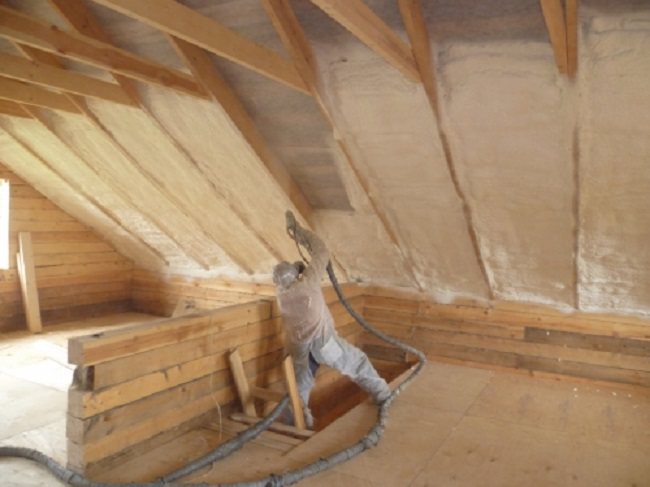

Whichever option of warming the gable is chosen, you should always use only high-quality materials. In addition, careful and painstaking work always brings good results. Warming a house is a very delicate procedure that does not tolerate neglect. Quality and high-tech execution - these two concepts are the key to success in any construction work.
Building a private house with a warm attic is a difficult task. But in the mass of construction and finishing work, you can find those that you can do on your own. For example, thermal insulation with a mineral wool pediment of a wooden house from the inside. But even in this issue there are many questions that should be resolved - which materials are better to use in the work, where to carry out the work: from the street or from the inside. Let's try to figure out all these questions in this article.
The thermal insulation of the brick and wooden pediment of the house does not tolerate trifles, especially if you decide to equip a room for children. First, you should consider the technology of work, materials for thermal insulation, think over the ventilation of the dwelling. Using proven materials, you will never go wrong. But what is the best way to insulate the gable at home so that there is no condensation inside the room?
How to insulate the pediment of a private house
With all the importance of insulating the attic with mineral wool, do not forget about the need to install high-quality metal-plastic windows, which must also be insulated, as well as about waterproofing the rafter system. In the first case, you will reduce heat loss in the house through the roof, in the second, you will significantly increase the service life of the entire roof in a private house, protecting the tree from fungus and mold.
Warming of the pediment with expanded polystyrene
Polyfoam does not meet modern fire safety standards and is harmful to human health, but at the same time, this material is the cheapest and most convenient to use. As for extruded polystyrene foam, URSA XPS or Technoplex is an excellent insulation for damp rooms. Expanded polystyrene plates can be easily installed on absolutely any surface, outside or inside.
Warming the gable of the house with mineral wool
Mineral insulation is considered a good option for a pediment. Mineral wool is harmless, has excellent heat and sound insulation. Glass wool has not lost its relevance today, URSA PureOne is non-flammable, easy to use and has low thermal conductivity. All modern heaters can be used. The main thing is what will be easier and more convenient for you to work with.
What materials should be used
Polyfoam is a common material, although foam plastic does not meet fire safety standards and is toxic. Moreover, it is not compatible with high humidity, which is essential for the attic pediment.
Glass wool is a well-known material, but has already lost its relevance. The low price is complemented by its incombustibility and low thermal conductivity, however, the problem lies in the inconvenience of working with glass wool.
Mineral insulation is recognized today as a more successful option for insulating the gable of the roof of a house. Minvata is environmentally friendly and has excellent sound insulation, and is also harmless to the body.
Penoplex is an excellent insulation that is easy to install. In addition, Penoplex is environmentally friendly and is not afraid of moisture. Suitable for insulating any surfaces, both outside and inside.
Warming of the pediment with mineral wool outside
All these heaters can be used in work, but the advantage should be given to mineral wool or penoplex because of their best characteristics. Another thing is what it will be easier for you to work with and what kind of insulation you yourself prefer.
It is best to insulate the gable from the outside, especially if the gable is made of blocks or bricks. The fact is that when insulating from the inside of a brick wall, the insulation is located on the side of the warm room, and the wall freezes through. As a result, a dew point appears between the masonry and the insulation layer, and then moisture, mold and mildew.
Often, insulation from the outside is simply impossible - the insulation will protrude beyond the facade of the building, and if the pediment is made of wood, it will be easier to insulate it with mineral wool from the inside. Therefore, we will begin the review with the question of how to insulate the pediment from the inside with our own hands.
How to insulate the pediment at home with your own hands
It is always better to carry out insulation outside, especially if the pediment of the house is made of brick. The fact is that when working from the inside, brick walls are under the influence of negative temperatures, a dew point arises between the masonry and the thermal insulation. When insulating from the street - all structures are reliably protected from freezing, and the dew point in the wall shifts to the insulation.
How to insulate the gable outside at home
Thermal insulation boards are attached from the street to glue for expanded polystyrene or to dowels between the bars of a pre-made frame. When self-warming the pediment with mineral wool, holes are pre-drilled onto which vertical bars of the required thickness are attached. In this case, the pitch of the bars depends on the width of the thermal insulation plates. Further, the pediment is covered with a roll vapor barrier.
To create a ventilation gap between the vapor barrier film and the cladding, slats of at least 20 mm thick are nailed onto the vertical bars. Further, the front is sheathed with vinyl siding. For insulation, it is better to use fiberglass or Paroc stone wool - the material perfectly retains heat, does not decompose, does not change its parameters at high temperatures outside.
How to insulate the gable of a house from the inside
It often happens that it is impossible to carry out insulation from the outside - decorative sheathing is made or the insulation will protrude too much. In this case, you will have to insulate the gable of the house from the inside - for this, the thermal insulation is placed between the beams of the wooden frame. For the attic laid out in half a brick, it will be necessary to additionally build a frame from a bar.
To begin with, all wooden beams should be treated with an antiseptic, then the entire structure is covered with roll waterproofing. Ideal when the gable frame is a fixture for basalt insulation. That is, the insulation is placed close to the wooden frame, it is advisable to lay the plates in two layers in order to avoid cold bridges in the structure.
Foil foam combines reflection and absorption of thermal energy, which reduces heat loss in the house in winter.
Due to the absorption of moisture from the warm air by the mineral wool, the thermal conductivity of the material increases. Therefore, a vapor barrier should be laid on the basalt insulation from the side of a warm room. Additionally, you can cover the front of a wooden house with foil foam, which is able to reflect up to 90% of thermal radiation back towards the living room in the attic.
Warming the gable in houses made of block materials
In houses of this type, experts recommend insulating the gable from the outside of the building, this excludes the appearance of condensation and freezing of the walls.
A violation of technology can cause a number of problems:
- a shift in the dew point inside the room leads to the appearance of moisture on the walls, temperature drops lead to its destruction;
- the appearance of dampness contributes to the development of fungus and mold - an unhealthy microclimate in the house;
- a cold bridge is formed along the wall;
- internal space decreases due to the thickness of the insulation;
- not all materials can be used in living spaces.
Stages of work
- Installation of the lathing. It is made from wooden blocks or a metal profile. The frame racks are installed at a distance of 58 - 59 cm in the light.
- Insulation is inserted between the elements of the crate and, if necessary, attached to the wall with special dowels.
- The windproof film, which protects the insulation from the external environment, is laid close to the insulation and is attached to the crate.
- A ventilated gap is made between the outer trim and the protective film, which is needed to remove moisture from the structure.
If the lathing is wooden, use bars about 2 cm thick, they will be used for external finishing materials: siding, block house or lining.
The effective operation of the entire insulating contour of the under-roof space, warmth and absence of dampness in the house largely depend on the correct insulation of the gable.
Before starting work
The decision to insulate the gable of the house should be taken carefully and deliberately. The very location of this structural element requires care and caution in the work, and the technology and method of insulation - to meet the set goals.


First you need to figure out what should happen in the end after the completion of the work. Installing one or more layers of insulation on the outside of only one attic pediment will not give the desired effect when it comes to creating a comfortable temperature under the roof. For the arrangement of the attic, even the insulation of all the gables of the house will not lead to the desired effect - here you also need to insulate the roofing part and install a multi-layer insulation between the rafters.
But in order to provide an air cushion under the roof, in principle, insulation is not needed - it is enough to simply seal the cracks hermetically.
Therefore, if a decision is made to insulate the pediment at home, then the process itself should be considered as one of the few operations in the total volume of work to ensure resource savings and create comfortable conditions in the home.
Insulation methods
When developing the sequence of work and methods of their implementation, you should not invent something new, it is enough just to use the experience of professional builders. In this regard, nothing supernatural has been invented. There are two ways to insulate the gable at home:
- From the outside;
- From the inside.
In principle, if funds and time permit, you can combine these two methods and install insulation on both the inner and outer sides of the pediment.
Both methods are used for all technologies for applying heat-saving coatings and materials, except that mats made of natural technical wool and rags are not installed from the outside - they are too hygroscopic in the open air. Otherwise, literally all materials can be attached both from the inside and outside of the structure.
What is a pediment: we understand the concept
Considering that the attic is under the roof of the house and has a special design, you need to pay attention to both the choice of insulation and the quality of the installation work itself. Before considering existing materials and methods of laying them, it does not hurt to get acquainted with the concept itself. So which part of the house is called a pediment? In fact, this is a part of the roof, or rather, its end sides, framed on the sides by slopes. They perform a very important protective function and protect the attic or attic from wind, snow, rain, hail.
In addition, they are also a very important element from the aesthetic point of view, so it is desirable that the pediments are not only made of high quality, but also have a decent appearance.
Depending on the design of the roof, their shape can be very different: triangular, trapezoidal, etc. Gables can also be erected from different building materials: brick, wood, cinder block. Since the attic is a living space, and it is used in many ways: someone equips it for an office, someone for a guest room, and someone makes a bedroom there, then, accordingly, the temperature there should be normal for living at any time of the year. Therefore, it is very important to pay enough attention to its insulation.
Insulation of the pediment from the inside
This method is not only safer compared to external insulation, but also allows the use of some non-standard technologies and materials. Working under the roof allows you to make the insulation better and not to look back at the weather conditions. Working under the roof also allows for the comprehensive implementation of the task of insulating the roof structure in preparation for the arrangement of the attic.
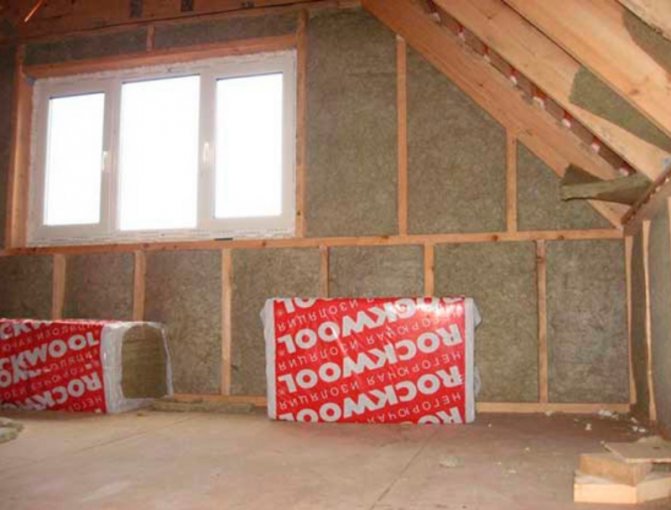

Warming the gable of the house from the inside
For insulation from the inside, the following are used:
- Mineral wool;
- Styrofoam;
- Penoizol;
- Natural natural materials;
- Foamed polyethylene;
- Gas and foam blocks.
The technology for installing an additional coating for wall insulation allows the use of materials with a higher density and weight.This is especially true for the insulation of the gables of buildings with interfloor floors made of reinforced concrete slabs. Considering that the slab is capable of withstanding a load of 450 kg per 1 square meter, the construction of an additional wall from foam blocks does not seem such an impossible undertaking.
Features of warming gables
The pediment is the upper part of the facade of a residential building (most often it is triangular in shape, but I have seen circular ones as well), which is limited by the roof slopes. In other words, if we assume that the two opposite walls of the attic are limited by the roof, then the rest are the gables.
These structural elements of the house have several important features that I would like to mention:
- The gables of a wooden house and a dwelling made of mineral materials are the supports for the cross beams of the roof truss system. That is, they experience the additional load exerted by the roofing material.


The pediment is the support for the cross-beams of the roof truss system.
- These parts of the building envelope are subject to significant wind loads. If they face the side from which the wind most often blows, do not make windows or doors to the balcony on them. Attic rooms will suffer from drafts.
- Thermal insulation of structures is carried out in the same way as the thermal insulation of the rest of the house. At the same time, in a building made of brick or stone, I advise you to do external insulation, and in a wooden house (especially a squared or log house) - internal. It's just that in the latter case, after insulation, you will most likely spoil the original appearance of the building.
- The pediment (that is, the material from which it is made) is worse than all other elements of the house protected from the destructive effects of the external environment. Therefore, along with insulation, I recommend protecting it from moisture, wind, and so on.


The pediment must not only be insulated, but also protected from the effects of destructive factors (in the photo this was done using siding).
Insulation of the gable outside
The external location of the insulation elements has several advantages over the location of the insulation inside. The first thing that needs to be emphasized here is that the internal space does not decrease, this is essential in conditions of a shortage of attic space. Secondly, external insulation is most often installed as part of a general house insulation plan, which means that the facade of the entire building will be reliably protected from cold penetration at joints and transitions.


Warming the gable of the house outside
Alas, external insulation somewhat constrains the maneuver for the use of certain technologies, but given the quality of the insulation, its density and installation system in no way affect the result of the work. It should be noted that for outdoor installation do not apply mats made of rags and natural cotton wool and natural plant insulation - mats made of pressed straw or reeds.
For installation outside the building, the following are used:
Mineral wool insulation
Basalt mineral wool today is considered one of the most promising insulation materials. Cotton wool is used for both outdoor and indoor installation, while choosing the dimensions of the plates, you can select not only the material according to the thickness and dimensions of the plates, but also according to the density of the material.
Among manufacturers, it has recently become fashionable to produce not just material for installation, but to create entire systems for work. Mineral wool is no exception in this series. Several types of material are supplied to the market for thermal insulation of facades, including facade systems for fastening with adhesive mixtures. Plates for installation in the factory are impregnated with a primer, as a result of which the plates themselves are more rigid. And the ease of installation is achieved by the presence of figured protrusions on the ends of the plates.
Technology for installing mineral wool on the outside of the pediment:
- A special perforated profile (or special brackets) is attached along the line of the lower edge of the floor slab from the outside of the building.


- On the roof, the wind board is removed from the side of the pediment.
- For brick or other block-type wall materials, a coat of primer must be applied.


- For pediments made of wood or fiberboard, an antiseptic treatment is carried out.
- Glue and slabs are being prepared.


- The glue mixture is applied to the slab in large 5-6 points and smeared. The slab is inserted into the profile and pressed tightly against the building.


- To enhance the adhesion, the plate is additionally fixed through the body of the screen with plastic dowels with large caps.


- Plates are installed on wood with self-tapping screws and washers.
- After installing the entire gable cover, the cotton wool is treated with a primer (or the same glue), and a reinforcing mesh is installed on it.


- Plaster is applied to the surface and facade paint on top of it.


- The wind boards are returned to the roof.
As a result, the layers should look something like the image below:
Outside
For insulation use:
- Styrofoam;
- penoplex (EPS);
- mineral wool, stone wool, basalt slabs;
- polyurethane foam;
- cellulose, ecowool.
One of two technologies is used:
- laying a heat insulator for wet finishing, plastering;
- ventilated facade.
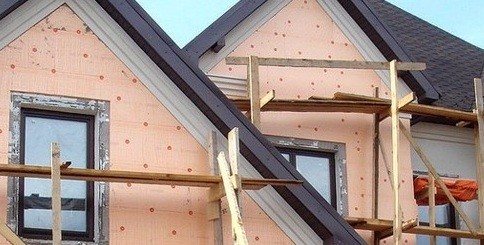

In the first case, the procedure is as follows:
- The surface of the pediment is cleaned of dirt and dust. It is primed.
- Penoplex or foam sheets are stacked in a row, starting from the bottom. Secure with adhesive and plastic dowels. The adhesive is applied around the perimeter, leaving gaps for air to escape in zigzags inside the sheet. Dowels, first of all, fix the sheet in the center, and after installing adjacent sheets in all corners and in the middle of the face, capturing all neighboring sheets with one fastener.
- On the part of the gable, the roof is bounded by lags, a strip of 10-15 cm of mineral wool is laid and fixed to create an air-permeable gap in the ventilation system of the under-roof space. Styrofoam sheets are trimmed to fit the slope border, taking into account the offset from the edge of the structure for laying mineral wool.
- Further, the surface of the pediment is plastered with reinforcement with a polymer mesh. The thickness of the plaster layer is at least 5 mm. Protective panels and ventilation grilles are fixed along the upper edges, where the mineral wool is laid.
- A visor is fixed along the interface between the pediment and the wall for additional drainage of atmospheric precipitation.
Only the outer finish and the coloring of the pediment will remain.
In the second case, using breathable materials and a ventilated facade, the procedure is as follows:
- On the clean and primed surface of the pediment, a support corner is fixed along the lower border and a visor, which will divide the space between the wall and the pediment.
- Next, a frame is attached from wooden beams 40x30 or a metal profile CD with a step of 600 mm. Mineral wool is laid in strips or slabs between the frame elements. The distance between the borders of the lathing elements should be 10-15 mm less than the width of the insulation to eliminate gaps and cracks.
- A vapor-permeable membrane is mounted on top of the insulation. The waterproofing layer is fixed with a counter lattice, fixed parallel to the frame elements. The ends of the counter-lattice elements should not reach the support corner and roof elements by at least 10 cm to form ventilation gaps. Next, the windscreen is fixed and another crate to secure the selected siding.
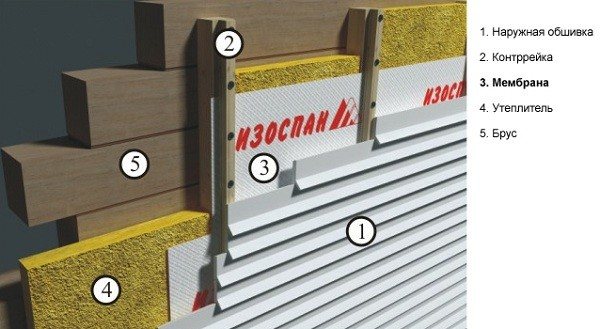

Mineral wool insulation scheme
Insulation with penoizol
The technology of applying liquid polyurethane foam to the pediment, both from the outside and from the inside, allows you to make a durable and reliable coating of the house structure.Foamed penoizol allows you to reliably seal any, even the most difficult surfaces, with a guarantee of excellent service for 30 years. To apply it, you must have a certain qualification and special equipment, so it is unlikely that you will be able to do the work yourself. But the cost of thermal insulation with polyurethane foam will pay off with interest - this material is of such high quality.


Warming of the pediment with penoizol can be done both outside and inside
The technology of spraying the coating ensures the spraying of liquid penoizol on any surface, while the high adhesion of the composition literally sticks it to any surfaces and materials. Processing is carried out using a spray gun. The maximum thickness of spraying for 1 pass is not more than 1 cm on the ceiling surface. After spraying, the layer dries up within 1 hour, after which the treatment can be repeated.
The maximum number of passes through one place is no more than 5. To obtain a larger thermal insulation layer, it is necessary to install a reinforcing screen made of fiberglass or metal mesh. From the inside, when spraying a layer of penoizol, it is recommended to fill the pediment with wooden blocks to the thickness of the required layer. The bars are installed vertically after 50-70 cm. The foam is sprayed in 4-5 passes, allowing the previous layer to dry completely.
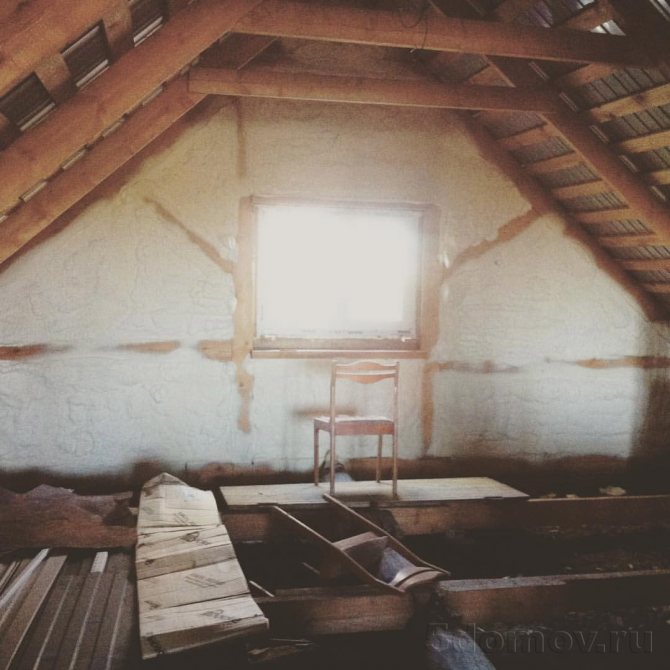

After the entire volume is filled, the excess nodules are simply cut off with a knife, and then the wall is plastered with plaster mixtures.
Preparation of materials for insulation
Residents want to insulate the entire attic area and at the same time do all the work on their own in order to save their money. It is possible to do the work with your own hands if you follow all the rules for insulation. The insulation of this dwelling can be carried out outside and inside.
In most cases, only two methods are used - thermal insulation from the outside and inside for siding. Usually the attic is a frame structure. Therefore, it is necessary to use those materials that are suitable for this particular design.
First of all, it is necessary to make a choice of thermal insulation, which will be intended for finishing the pediment. Then you need to calculate the thickness of the layer of the insulating layer. Also calculate the amount of material required. The materials intended for waterproofing and vapor barrier of the pediment also need to be taken care of. For this procedure, special membranes are used. Additionally, you need to impregnate the wood structure with an antiseptic.
Foam insulation
Foam is available on the market today in several material variants, in particular, conventional foam and extruded. The first type of material is in the form of slabs consisting of compressed granules. The second has the form of a monolithic formation with a large number of air cells. The difference in these two materials of the same type lies in density - the first has several density categories, but the densest conventional foam is lower in density than the extruded lowest density.


The usual type of foam is used mainly for external insulation, extruded - mainly installed inside the building. The first is combustible, the second has fire-fighting properties.
The installation technology is in many ways similar to the installation technology of mineral wool slabs. A zero rail is also mounted, glue is also applied, and the plate is fixed with dowels. The difference lies in the fact that the joints of the slabs are still processed with glue, which gives the structure more rigidity and excludes the penetration of air into the space under the slabs.
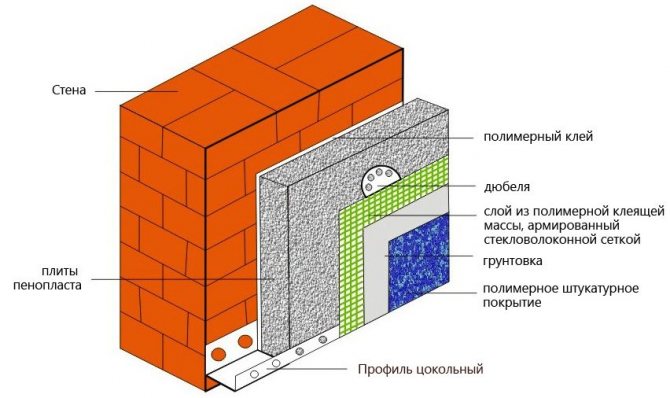

Wall insulation scheme with foam
Warming with natural materials
The popularity of environmental programs could not ignore the topic of the production of heaters.One of these new materials used to create a thermal insulation layer is straw or reed fascines.


The structure of this material consists entirely of natural fibers. Before getting to the construction site, the material is thoroughly dried, treated with antiseptics and bound into mats. Actually, insulation with the help of straw or reed stalks was used in housing construction until the mid-50s, so, given the service life of such a heater, there is nothing strange in the fact that it has received a second wind today.
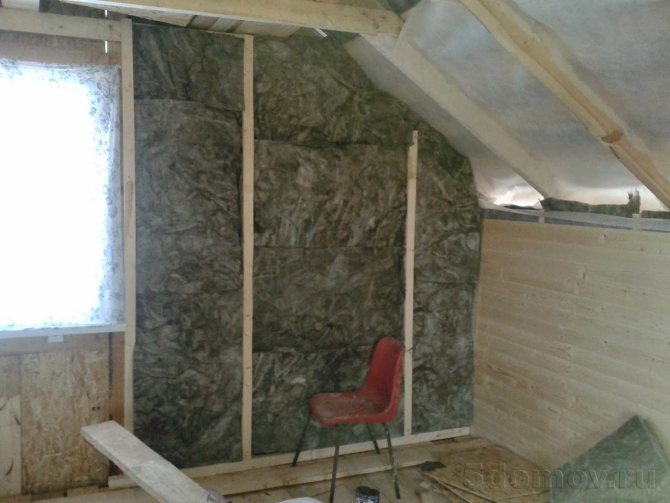

On the inside of the pediment, after installing a wooden lattice, steam and waterproofing, the insulation elements are installed on top of each other and fixed to the lattice with self-tapping screws with large caps.
To strengthen the insulation, it is treated with a primer and a reinforcing fiberglass mesh is attached with self-tapping screws. The plaster solution is applied in the same way as on a regular wall, with the only difference that the reinforcement will have to be done for the second standing plaster.
Recently, the method of application is often used for internal thermal insulation. clay solution with natural fillers. This method is also environmentally friendly as it does not contain harmful chemicals. The method is based on the principle of increasing the wall thickness by installing an additional layer of clay plaster with fillers from natural materials.


The filler is sawdust or small shavings and finely chopped straw. The filler mixed with clay is poured with water and mixed thoroughly. Wooden blocks are installed on the pediment in the same way as for penoizol. Using a painting bucket, the solution is poured onto the wall and leveled with a trowel. The filled niches should dry well before proceeding to the next stages of work. After drying, a dense and reliable layer of plaster forms.
Insulation with foam and gas blocks
The gables of private houses are mostly of a small thickness. It is for this reason that they are not able to provide reliable thermal insulation of the attic space and require additional thermal insulation. When implementing a project to rebuild the attic space into the attic, it is rational to insulate the gable from the inside, additionally building a wall of foam or aerated blocks.


An increase in the thickness of the pediment wall by 30 cm will significantly reduce the penetration of cold into the attic through the pediment on one side, and on the other hand, such a wall makes it possible to improve the sound insulation of the room.
For installation, solid blocks are usually selected, but if it is possible to build a wall from blocks with voids, such an additional air gap will definitely provide better thermal insulation. Laying is carried out from the inside of the pediment:
- First, waterproofing is installed on the slab - a layer of roofing material or polyethylene;
- The first row is laid on a layer of mortar and leveled in height;
- The laying of the second row is carried out in compliance with the rule of block displacement by 1/2 block;
- During the work, the blocks are adjusted in size to the slope of the roof.


- The finished wall is primed and plastered.
The second version of the construction of the wall provides for the formation of an air gap of 5-10 cm between the pediment and the blocks.At the same time, so that cold air does not penetrate into the space, the extreme blocks of the rows are installed so that they touch the wall tightly and thus form a completely sealed space.


The use of different technologies for warming gables allows you to obtain significant savings in resources due to the formation of a sealed attic space above the living quarters, which can reduce the heat loss of the building to 12-13% of the total heat loss.And this means that the work performed on warming the gables will pay off literally in the first heating season.
From within
For internal insulation, the usual approach is used to form a sandwich panel or frame-type insulation. The outer border is sheet material made of moisture-resistant chipboard or sheathing along the frame with edged board. From the outside, the shield is protected by a windproof and a vapor-permeable membrane, and an external finish is attached to the crate. A frame made of wooden beams or a metal profile is attached from the inside, between which the insulation will be fixed.
It is best to use the same insulation as for the roof, or mineral wool without any tweaks. For materials such as polystyrene or polyurethane foam, the external and internal finishing of the pediment must be moisture-proof, not forgetting about the installation of ventilation ducts for the under-roof space. The latter option is not applicable in the presence of roof support structures as part of the pediment. If these are wooden beams, then they need to provide ventilation to remove moisture, therefore, it is preferable to use vapor-permeable materials.
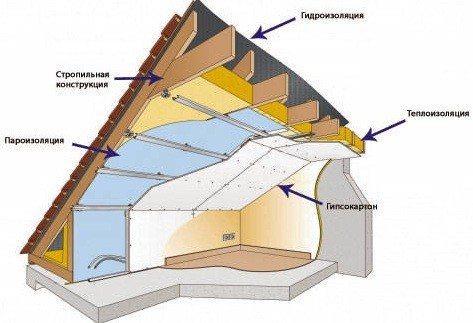

Insulation scheme from the inside of the attic
Work order:
- The main frame is assembled from 50x150 (200) boards. They must be fixed between the base of the wall and the joists in parallel along the wide side at a distance of 590-600 mm from each other so that the gap between them is 10-15 mm less than the width of the insulation used.
- On the outside of the frame, a sheet of waterproof chipboard or edged board treated with protective compounds is stuffed. Next, a vapor-permeable membrane is attached and a windscreen along the crate with a 25x30 or 30x40 bar. The last layer is siding.
- From the inside, between the elements of the frame, mineral wool is laid. Channels are laid or gaps are formed, combining the ventilation of the under-roof space with the ventilation of the gable insulation layer.
- A vapor barrier membrane is fixed along the entire plane of the pediment with an entry onto the roof slopes and joining the roofing cake with a vapor barrier screen. On the lathing with a 30x40 bar, fixed perpendicular to the frame, the interior trim is attached.
Interior decoration can be plasterboard, lining or PVC panels. This is where the warming of the gables ends. With the correct choice of insulation thickness, the outer surface of the pediment under the cladding is 1-2 degrees higher than the outside temperature, due to which active ventilation and removal of excess moisture and condensation are maintained.



